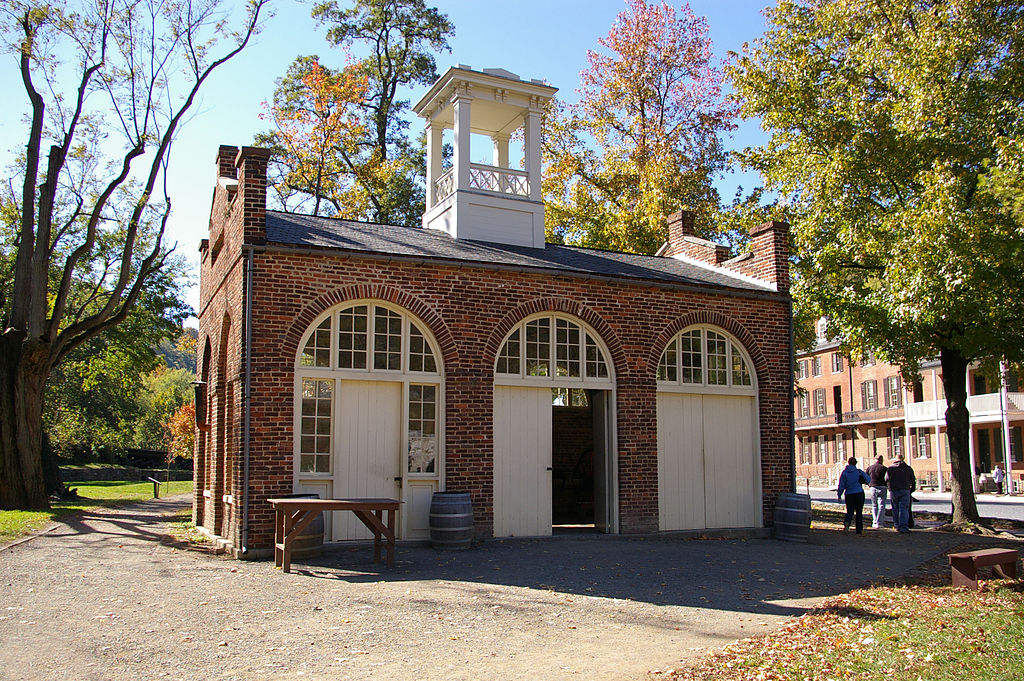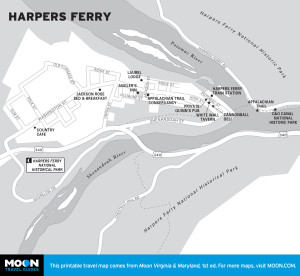
John Brown’s Fort, built in 1848 is the only Armory building that survived the Civil War. Photo © MamaGeek, licensed Creative Commons Attribution.

Harpers Ferry, West Virginia
The Harpers Ferry National Historical Park (304/535-6029, daily 8am-5pm, $10 by car, $5 on foot) is made up of 3,700 acres of parkland and the lower portion of the town of Harpers Ferry. It features more than 25 historic buildings along Shenandoah Street, High Street, and the Potomac Street areas. The town sits at the confluence of the Potomac and Shenandoah Rivers (which makes it prone to flooding during high water).The best way to begin exploration is to park at the Visitors Center (171 Shoreline Dr.), tour the center, pick up a map of the town, and then hop on a bus to the historic downtown area. It is possible to drive into the historic downtown area, but there is very limited parking since the park service does not allow street parking in an effort to preserve the original look of the town. There is a small parking lot at the Harpers Ferry Train Station on Potomac Street.
The park includes many 19th-century homes that were erected by the federal government for people working for the Harpers Ferry National Armory. The armory mass-produced military arms for the United States and was one of two such arsenals in the country (the other was located in Massachusetts). The armory was the site of the famous raid by abolitionist John Brown in 1859, who although unsuccessful, tried to start a slave revolt prior to the American Civil War. After the war started, the armory became an important point of control for both armies since it was near the Mason-Dixon line. Its strategic location resulted in much turmoil for Harpers Ferry, as the town changed hands numerous times during the war.
The armory site became the location of the Harpers Ferry Train Station in 1889 and remains as such today. John Brown’s Fort (which was the armory’s guard house) is the only surviving building from the Civil War. It was moved several times and now sits approximately 150 feet east of its original location (since the original site is now covered by the railroad).
Victorian and federal-style homes in the town entertained well-known guests such as Woodrow Wilson, Mark Twain, and Alexander Graham Bell.Victorian and federal-style homes in the town entertained well-known guests such as Woodrow Wilson, Mark Twain, and Alexander Graham Bell. General Stonewall Jackson also spent time in Harpers Ferry during the Civil War when he used the town as a command base.There are many museums and historic landmarks in town, including a museum on Meriwether Lewis, who came to Harpers Ferry in 1803 to purchase weapons from the U.S. National Arsenal for his transcontinental expedition. Among the items he bought were 15 rifles, 15 powder horns, 30 bullet molds, knives, tomahawks, and repair tools. Another landmark is White Hall Tavern on Potomac Street. The tavern was owned by Frederick Roeder, the first civilian casualty of the Civil War in Harpers Ferry. The tavern was a drinking house for armory employees but was taken over by Northern forces after Roeder’s death and used as a site for strategic planning. It was located on the south side of Potomac Street across from the original armory (now the train station).
Another historic building in the park is the Stipes’ Boarding House (Shenandoah Street) where Cornelia Stipes took in visitors during the Civil War. Among others, she hosted military officers and one of the first war correspondents, James Taylor, who captured pieces of the war in his military sketches. Other buildings include a mill, blacksmith shop, dry goods store, and bookshop. Just outside the historic park area but still within the town of Harpers Ferry are shops and restaurants that are easily reached on foot.
The park is technically located in three states—West Virginia, Virginia, and Maryland—and is managed by the National Park Service. Harpers Ferry National Historical Park offers many opportunities for outdoor adventure including trail hiking, boating, biking, and guided ranger tours. Visitors can get a lovely view of the water gap where the Potomac and Shenandoah Rivers meet by hiking up to the spot visited by Thomas Jefferson on October 25, 1783, now called Jefferson Rock. From the lower part of town, make your way to High Street and the stone steps that lead up to St. Peter’s Church. The steps continue past the church and turn into a steep 5-minute climb. The view is spectacular, and you will find out why Jefferson said it was “worth a voyage across the Atlantic.” Much of the park is tree covered, and there are more than 170 bird species and 30 mammal species in the park.
Excerpted from the First Edition of Moon Virginia & Maryland.